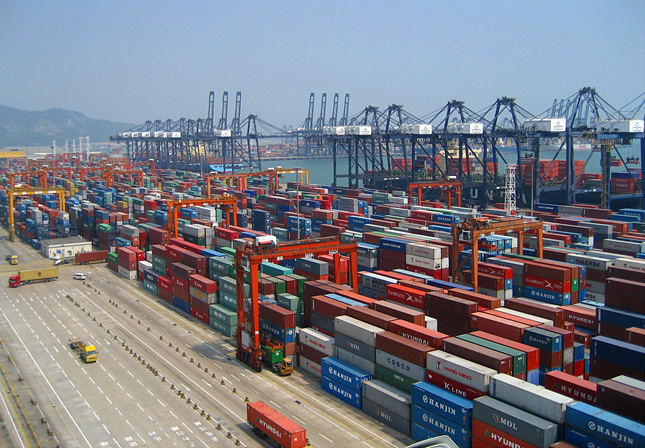-
Cleaning up China’s Ports: Shenzhen Explores Fuel Switching and Onshore Power

China’s “strictest air protection law” yet took effect on January 1, 2016, promising to bring big changes to its smog-filled cities. But some municipal governments have been ahead of the curve, working to clean up the air through experimentation and innovation. Shenzhen, China’s first special economic zone and which recently passed its neighbor Hong Kong to lead China’s most competitive cities, is one of these.
Since it was named the nation’s first model city for environmental protection in 1997, Shenzhen has focused on innovative technology to boost not only its economic development, but its sustainability. In 2013, Shenzhen became one of seven cities to pilot China’s regional emissions trading system, and an Air Quality Enhancement Plan released the same year has achieved considerable progress in limiting air pollutants, including by regulating marine traffic to and from its busy port.
In December 2015, the Wilson Center’s China Environment Forum (CEF), together with the International Council on Clean Transportation (ICCT), released a report, Costs and Benefits of Shore Power at the Port of Shenzhen, discussing air quality trends and potential ways to control air pollution from ships and port-related activities. The white paper comes just as the newly implemented air law is set to rock the air pollution “boat” at berth.
The report contributes to the “Choke Point: Port Cities” project, by the China Environment Forum and Circle of Blue, that has been closely studying energy and water trends in Oakland and Shenzhen, and builds on five years of “Global Choke Point” reporting and convening on water-energy-food confrontations in China, Australia, the United States, India, Mongolia, and the Arabian Gulf.
Leading the Way
As a leading city in the Pearl River Delta, one of the world’s largest urban areas with 60 million people in total, Shenzhen’s municipal leaders have taken aggressive action to address the city’s pollution. Shenzhen has shifted toward greener and cleaner industries and adopted stricter regulations. Shenzhen’s port, one of the busiest in the world, gets special attention in the Air Quality Enhancement Plan. The plan offers guidelines in five key areas:
- It recommends feasibility reports on onshore power development to replace shipboard electricity generation while at berth by connecting ships to the grid and reducing emissions from diesel engines. By the end of 2015, the port was to provide more than 15 berths offering onshore power supply.
- It requires fuel switching for all trailers and container cranes from oil to gas and electricity.
- It encourages the use of low-sulfur fuel by vessels by subsidizing 75 percent of price differences. By 2015, 85 percent of port vessels were supposed to using low-sulfur fuel.
- It promotes dual-fuel marine engines by offering grants and subsidies.
- It enacts a speed limit of 12 knots (14 miles per hour) on the coastal waterway.
These changes to port operations and other strategies have helped Shenzhen become one of the top Chinese cities with regard to air quality. In 2015, Shenzhen achieved the national target to keep small particulate matter under 30 micrograms per cubic meter of air two years before the mandated deadline and lowered sulfur dioxide and nitrogen oxides emissions significantly, much in contrast to Beijing, where small particulate matter measured more than 80 micrograms per cubic meter.
Trade Offs
The CEF-ICCT report focuses on two key targets in the Shenzhen Air Quality Enhancement Plan: the development of onshore power and switching to cleaner marine fuel. A quantitative analysis examines the city’s economic and technological capacity to implement the changes and provides policymakers with better insights into constructing a greener port.
Enabling onshore power for ships at berth could reduce particulate matter by 95%According to our analysis, enabling onshore power for ships at berth, which would mean purchasing electricity from Hong Kong, could reduce emissions of sulfur dioxide by 88 percent by 2020, nitrogen dioxide by 94 percent, carbon dioxide by 37 percent, and particulate matter by 95 percent.
Simply switching fuel sources from a higher sulfur content diesel fuel to marine gas oil could reduce particulate matter by 80 percent as well, at a cheaper rate, but would not reduce nitrogen oxides. The returns are also easier to attain because switching fuels requires no changes on the shipside, whereas hooking up to onshore power sometimes does.
In addition to assessing these two options, the report strongly recommends increased partnership with ports in California, like Oakland. Shenzhen has installed a number of onshore power supply facilities, but their operation rate is quite low and could benefit from lessons learned by its close trading partners in California, where most container ships are required to use onshore power. Such partnerships represent a unique opportunity to exchange ideas and solutions.
The timing for more collaboration is ideal. The joint U.S.-China presidential statement on climate change in November 2014 included mention of green ports and vessels. More recently, in September 2015, Shenzhen and Los Angeles were listed in a memorandum of understanding signed during the U.S.-China Climate Leaders Summit to “share best practices and lessons learned in reducing emissions,” especially “from vessels visiting their respective major ports.” And Guangdong and California are among the regions in each country leading the way on climate action and setting ambitious emission targets.
The analysis in the CEF-ICCT report lays the foundation to better understand trends in port emissions in China and viable solutions to control them. Already taking the lead in cleaning up China’s urbanization process, Shenzhen is poised to do the same with its port and serve as a model for others across the globe.
Zhou Yang is a research intern for the China Environment Forum. Xiaoli Mao is a program associate on the ICCT Marine team. She supports maritime research on international vessel efficiency and pollutant emissions.
Sources: International Council on Clean Transportation, Natural Resources Defense Council, Shenzhen Municipal Government, South China Morning Post, The White House, Wen Wei Po.
Photo Credit: Shenzhen container port, courtesy of flickr user Bert van Dijk.
 A Publication of the Stimson Center.
A Publication of the Stimson Center.







